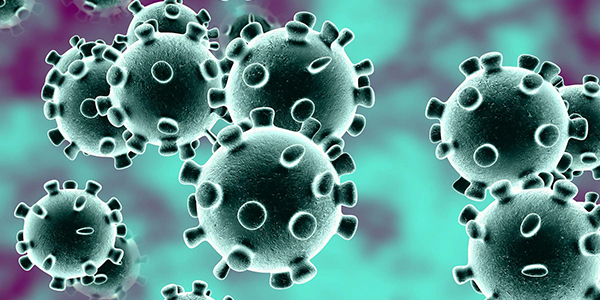
Tools for Public Health and Community Action
The Coronavirus disease outbreak threatens our communities, locally and globally. Working together, we can strengthen the public health and community response that will help protect all of us.
Below, please find links to useful tools drawn from authoritative sources—the World Health Organization and the U.S. Centers for Disease Control and Prevention—and from the Community Tool Box, used by nearly 6 million people worldwide.
TOOLS FOR PUBLIC HEALTH ACTION
If you are looking for ways you can make a difference as an individual, we encourage you to visit Make Good Together to make a pledge to be a leader within your social circle and to find ways to exercise leadership.
GUIDANCE FOR COMMUNITIES
CDC: Guidance for schools and childcare programs
CDC: Guidance for schools, workplaces, and community locations
CDC: Resources for community and faith-based leaders
Community Commons: Coronavirus Response: Peer-to-Peer Resource Sharing
Community Science Webinar: How to Ensure Equitable Development as We Rebuild
County Health Rankings COVID-19: Response and Recovery Work
COVID-19 Peaceful & Self-Care Strategies
COVID-19: Using a Racial Justice Lens Now to Transform Our Future
COVID-19/Coronavirus Resources Crowdsourced from Local Governments
Grantspace: Emergency Financial Resources to Help with COVID-19 Hardships
NLC: COVID-19 Pandemic Response & Relief
Social Equity Considerations: An Imperative in a Time of Pandemic
Total Worker Health® Employer Guide: COVID-19 Edition
Voices for Healthy Kids Action Center
COMMUNICATING THE THREAT AND RESPONSE
CDC: Frequently asked questions
CDC: Guidance for public health communicators
CDC: Overall information on coronavirus
Kaiser Family Foundation’s State Data and Policy Actions to Address Coronavirus
WHO: Overall Information on the coronavirus disease pandemic
WHO: Questions and answers on coronaviruses
DATA
The University of Chicago Center for Spatial Data Science’s US COVID Atlas
PROTECTING AND CARING FOR YOURSELF AND FAMILY
CDC: How to protect different groups of people
CDC: If you are sick or caring for someone
Grantspace: Emergency Financial Resources to Help with COVID-19 Hardships
Staying Physically Active During the COVID-19 Pandemic
USDA Meals for Kids Site Finder
WHO: Advice for the public, how to protect yourself and others
GUIDANCE FOR HEALTH AND PUBLIC HEALTH WORKERS
CDC: Guidance for health departments
CDC: Information for health care professionals
Kaiser Family Foundation’s State Data and Policy Actions to Address Coronavirus
Public Health & Equity Resource Navigator
WHO: Advice for health workers
WHO: Online training for infection prevention and control
WHO: Technical guidance for public health response
Examples of Communities Taking Action
The Community Tool Box team is proud to be partnering with the Society for Community Research and Action and the European Community Psychology Association on The New Bank for Community Ideas and Solutions in response to coronavirus outbreak. For additional inspiration, view these Altruistic Stories and COVID-19 compiled by the Center for Peace and Conflict Studies at Ball State University.
ARTS
Cultural Community Corona Response: Remember Your Old Drive-In Cinema

The sixties brought something new from the US to Germany. Drive-in cinemas became the hot-spot for couples, lovers, and families, and they could stay in their car. In the late eighties most drive-in cinemas had been abandoned due to new media. Read more.
Muncie Theater Costumers Sew for Life-and-Death Drama Now

Although the shows may be put on hold for the time being, many theater costumers nationwide are nonetheless keeping busy at their sewing machines. When Laura Williamson, the executive artistic director of the local Muncie Civic Theatre, saw a costumer making medical masks, she got the idea to have all Muncie Civic Theatre costumers dedicated to the task – and all willingly jumped on board. Besides the Civic volunteers, members from the Ball State theatre department are also engaged in the effort, alongside additional local volunteers. In total, twenty theater seamstresses and costumers are working to make masks with what they have, taking about fifteen minutes or less to make each mask. The local Joann fabric store in Northwest Plaza has taken the lead in supplying material for these efforts, providing free mask making kits to the volunteers. Many of the volunteers feel that it is their way to do something, anything they can during this difficult time for many. Read more.
Music and Culture is Building New Communities

It started as a ‘wow’-event for me when in Italy hundreds of people started to sing each day form their balconies during the first days of the lock-down. Then a semi-professional opera choir launched an online version of Verdi’s ‘Va Pensiero’. In the meantime, thousands of musicians and other artists started regular live community and online events all over the globe. Read more.
Street Art Keeps Spirits Up and Connects During Lockdown

One resident bought some chalk for his children to use and started writing messages when it was a birthday or an anniversary; these messages of congratulations and solidarity can be seen from our second story windows. Children from the area started adding portraits so that it looks like they are all holding hands, something that they cannot not do during lockdown. The idea was first started by children but soon it became a focus of the street, with every resident (including pets) being included in this collective portrait. Read more.
FOOD
Atlanta’s Compassion Kitchen: Supporting Local Restaurants and Serving Those in Need

Since launching in response to the COVID-19 crisis, The Compassion Kitchen Project has helped to supply thousands of meals to nonprofits and those suffering from food insecurity, while supporting the local restaurant industry in Atlanta, GA. Using donations, the organization pays restaurants to make food for Atlanta-area nonprofits. This project is connecting the needs in their community with locally-owned restaurants and providing an efficient way for individuals to arrange for the delivery and payment of meals with a tax-deductible contribution. While volunteers are not permitted to cook, individuals are donating to-go bags of http://cathedralctk.com/compassion-kitchen/nonperishables. Read more.
California Pays Restaurants to Deliver to Seniors in Need

California Governor Gavin Newsom has announced “Great Plates Delivered,” a plan to bring three nutritious meals a day to seniors and other high-risk populations while providing meaningful work to those who have lost their jobs due to the coronavirus pandemic. This plan supports restaurants to rehire or retain staff to prepare the meals and deliver them to those in need. Read more.
Caring and Fast Response in a Small Bavarian Community
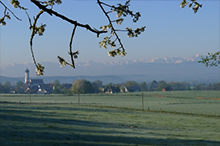
PAEHL (Southern Bavaria, Germany) is a small community of 2,000 inhabitants in a picturesque location south of Munich and close to the Alps. Although it is well known for a rich community life (traditional music bands, soccer, clubs maintaining local traditions), the corona lockdown came as a surprise. However, a short time after, the community came together to support vulnerable groups. Read more.
Cincinnati High School Student Creates Website for Grocery Delivery

Trip Wright, a 17-year-old sophomore at St. Xavier High School in Cincinnati, was looking for a way to get involved in his community during the pandemic and was inspired by a college student who created a grocery and prescription delivery service in New York City called Invisible Hands Deliver. After only six hours of thinking and planning, Wright created the website called zoomfooddeliver.com to service the Cincinnati area in a similar way. He has raised $1,000 in donations so far, which have been used to cover the cost of gas, hand sanitizer, disinfectant wipes, gloves and masks for volunteers who are making deliveries. If there is an excess of donations at the end of this, the money will be donated to a local food bank. Learn more.
Connecting Farmers to Food Banks
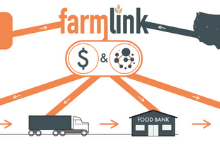
The FarmLink Project founded by 20 college students has delivered almost 240,000 pounds of food from farms to local food banks. The group of students fundraises, obtains surplus produce from farmers and suppliers, and then pays for the transportation and delivery of the items to food banks. All of the donations to the organization go to paying the wages of farm workers and truckers; so far, almost $5,000 of wages have been paid to workers. Read more.
Leaders are Stepping Up to Support Access to Healthy Foods
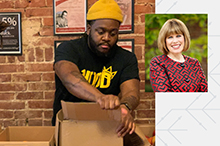
“In the best of times, eating is a challenge for far too many Americans. Eating healthier is even tougher. Now imagine what those folks are facing during this pandemic.” Learn more about what leaders are doing to creatively provide communities with nutritious food. Read more.
Making Sure Kids Get Fed during School Closures
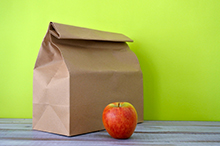
Food service professionals and other community members are stepping forward to ensure no child goes hungry. Millions of kids across the US rely on school meals for essential nutrition. Communities are getting creative; some schools are delivering meals or hosting meal drive-throughs for families. Learn more about these efforts in this article from Voices for Healthy Kids: “Amid Pandemic Shutdowns, Schools Make Sure Kids Get Fed." Read more.
Publix Supermarkets are Buying Food from Struggling Farmers
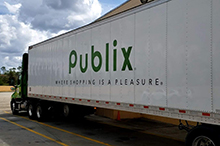
The US supermarket chain Publix recently announced its new initiative to purchase fresh produce and milk to assist farmers impacted by the coronavirus pandemic. Publix will be donating these products directly to Feeding America member food banks within its area of operations. The initiative is expected to run for several weeks and is expected to result in more than 150,000 pounds of produce and 43,500 gallons of milk donated in just its first seven days. The program will primarily support Florida produce farmers, southeaster dairy farmers and the growing number of families using the resources provided by Feeding America like fresh fruits, vegetables, and milk during the pandemic. With many reports of farmers having to discard of produce and milk, Publix hopes to address the needs of both the farming community and its local partner food banks through its initiative. Read more.

An initiative that involves women from the residential community of Surat, India, cooking five extra rotis each has become a massive lifeline for migrant workers who are suffering amidst the COVID-19 lockdown. The initiative was started by NGO, Surat Manav Seva Sangh ‘Chhanyado’. Women from across the city cook extra rotis or flat bread that are collected and taken to the NGO’s community kitchen in the city. The kitchen is staffed by 16 women who exclusively make vegetable curry and chili pickle, packing the rotis collected from the households along with it. The food packets are then distributed to about 35,000 people in need in different parts of the city. Read more.
School Districts are Handing out Meals to Students and Adults Alike
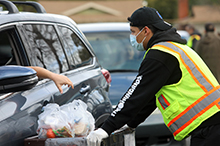
In March, the COVID-19 Child Nutrition Response Act was passed to help schools keep providing nutritious meals to its students. School districts are handing out meals but are not limiting these meals to students. Instead, many school districts are feeding anyone who shows up to receive food. One school district official from Los Angeles said, “we know that these aren’t normal times, so we’re serving all in need.” Read more.
University of Iowa Lecturer Delivers Thanksgiving Meals to her Students

Professor Elizabeth “Liz” Pearce of University of Iowa was worried about her students. It had been a difficult, lonely semester for many, given the restrictions imposed to stem the spread of COVID-19, and Pearce knew that the pandemic would force some students to celebrate in quarantine. “I was afraid many of them might be spending the holiday alone, without a proper Thanksgiving meal… I’m a mom and wouldn’t want anybody to feel alone and sad.” Many area businesses that employed students had been closing because of the pandemic, so a lot of her students had also lost their sources of income. Pearce decided to take them all under her wing for the holiday. She drafted an email to all 130 of her students offering them a home-cooked family dinner, explaining that her four kids had all volunteered to make extra portions of everything they were planning to serve at their own family meal. The professor’s kindness drew attention. A lot of attention. One of her students tweeted a screen capture of the email with the caption “My professor is absolutely too pure for this world.” Within a few hours, the post had over 1 million likes and 70k retweets. “It was just such a warm and fuzzy moment, and I wanted to share it,” the author of the post said, “I was so blown away with the response and how many people were as touched with Dr. Pearce’s act of kindness as I was.” Pearce, who has a reputation for being engaged with and compassionate toward her students, said it was “no big deal” to offer the holiday feast: “I just wanted everyone to know that there was room at my virtual table.” Read more.
HOUSING
Oakland Enlists Hotels to House the Homeless

On March 16, California governor Gavin Newsom issued an order to provide housing for people living in homeless camps in California. This order urged local governments to make shelter available for their homeless population. In Oakland, 393 rooms across two hotels were secured to house the homeless during the coronavirus outbreak. Read more.
Storytelling Turned Housing Advocacy

In San Francisco, the Bay Area's Health Justice Collective (BAHJC) transformed their pre-existing Policy Through Storytelling to focus on tenant rights and protection advocacy during the current COVID crisis. As a result of their COVID response, BAHJC is seeing a growth in the number and strength of their network as well as an influx of positive messages from community members.
INSPIRING HOPE

During the coronavirus outbreak in early 2020, my own community near Boston, like a great many others, strongly encouraged residents to stay inside their homes. Not surprisingly, community members wanted to find ways to have visible contact with others, even if they couldn’t meet directly with them in person. Some planners in town proposed an idea they called “6 Feet at 6PM.” Neighbors on a street were encouraged to come outside their homes at 6:00 every evening, to wave, greet each other, and talk while maintaining a distance of six feet or more. This would be a safe and healthy way to maintain social contact under new and challenging circumstances. Read more.
Connecting through Music
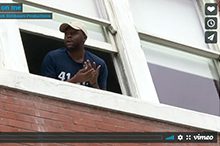
Some residents are showing unity and inspiring hope by singing together from their apartment windows, including a neighborhood in Italy singing “Volare” and residents in Dallas, Texas singing “Lean On Me.”

Several years ago, a young couple moved to the mid-sized city of Lowell, Massachusetts. They became attracted to the city’s diversity and spirit, and soon wanted to give something back to their new community. But without money or special expertise, what could they do? Read more.
Factory Workers Clock Out of 28 Day Shift to make PPE Materials
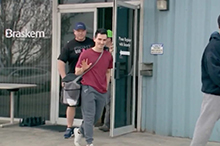
On March 23rd, 43 Braskem America factory workers entered the longest shift of their life. For 28 days, none of the workers left. The petrochemical plant, located in Marcus Hook, Pennsylvania, was transformed into a “live-in” factory to ensure that no one caught the virus outside. Individual offices became bedrooms, filled with air mattresses and personal belongings. The office kitchen became a dining hall. The emergency operations center became the new lounge. The 43 workers spent 12-hour shifts for a month straight in order to produce tens of millions of points of raw materials that will end up in face masks and surgical gowns to be used on the front lines of the pandemic. All of the workers were volunteers (meaning that their CEO did not tell them they had to do it), hoping to meet the increasing demand for polypropylene, which is used to make many medical items. Read more.
Ferret Runs a Marathon for Charity
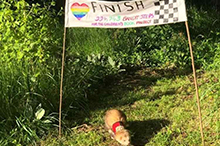
In Oxford, England, Bandit, an eight-month-old ferret, is running a marathon to raise money for the Children’s Book Project. Bandit, fitted with a harness and leash, runs three miles a day at two miles an hour in Shotover Country Park close to his home. The Children’s Book Project aims to build literacy by providing free books to schools, day care centers, prisons, foodbanks, and other nonprofits working with children. Bandit finished his marathon in three weeks and raised over $2,300, which was used to give book bundles to each child at thirteen Oxfordshire schools. Read more.
Reducing Maternal Mortality Disparities in the Pandemic
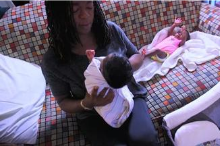
In Bridgeport, CT COVID-19 has elevated the importance of doulas’ work through the United Way infant and maternal child health program. Doulas have been shown to lower birth risks and decrease labor time, and they also serve as advocates in navigating the health system, something that takes renewed significance as our health care infrastructure experiences unprecedented strain. United Way has been working to leverage telehealth channels to promote this work since the number of people allowed to be present at hospital births have been reduced.
Upcycled Graduation Gowns to Help End PPE Shortage
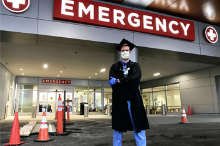
Gowns4Good is a charity that upcycles graduation gowns to hospital facilities that lack the necessary PPE to safely operate during the coronavirus outbreaks. With millions of young American students graduating from university every year, this initiative could potentially end the PPE demand for gowns in just a few days. “Graduation gowns are more effective than other PPE alternatives given their length, sleeves, and easy zippered access,” reads the organization’s website. So far, 10,175 gowns have been donated to medical facilities, and 87,630 gowns have been requested by medical facilities. Read more.
Girls Spread Hope to Those in Need

Girls Gang, a community action group for teenage girls in a disadvantaged community produced positive posters to be included in food packages being sent to families experiencing poverty and hardship during lockdown. The group wanted to do something to help the community but felt limited in ways they could enact their citizenship during lockdown. Messages in the posters included words of hope, tips for coping with lockdown and also telling residents that they were not alone. Read more.
Irish Citizens Support COVID-19 Relief Efforts for Native American Tribes

In 1847 during the Irish Potato Famine, the North American Choctaw tribe raised $170 (almost $5,000 in today’s currency) to contribute to Ireland’s relief fund. Now, 173 years later, donors from Ireland are raising money for the Navajo and Hopi tribes’ COVID relief fund. The Navajo and Hopi tribes have been hit hard by the COVID-19 pandemic, likely because of a lack of running water in one-third of all homes and grocery shortages. Now, over $3.4 million has been raised so far, with most of the donations coming from Irish citizens expressing gratitude for the help their ancestors received. Read more.

Leverett is a small rural town in Western Massachusetts of 1,700 people. Our local community building group, the Leverett Alliance, listening to community voices, decided to launch a town-wide listserv. Until then the town had no way to connect, exchange info, etc. Read more.
Mother-Daughter Duo Use Animation to Help Kids Cope

Ten-year-old Sydney of Everett, WA was starting to feel hopeless about being in quarantine but decided to turn her worries into action by writing, recording, and animating her own YouTube series with her mom’s animation software from her teaching courses. The series, entitled Kids Coping with COVID-19 was created with the intent of getting information about the virus out to kids her age in a way that they would be able to understand. The videos discuss how kids can have fun safely and arrange playdates online, but they also have turned into a way for students to take action in their communities. Read More.
Peaceful Ways to Express Ourselves and Help Others

The Advisory Board of the Ball State University Center for Peace and Conflict Studies has generated this list of peaceful ways to express ourselves and help others in this time of extraordinary crisis. Examples include, greeting everyone (from a safe distance) with a smile, tend to something growing, and do something to raise your heart rate. Read more.
Scuba Diving Group Makes Masks from Recycled Ocean Plastic
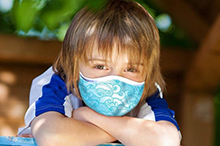
The Professional Association of Diving Instructors (PADI) has partnered with the sustainable sportswear company Rash’r to make face masks out of plastic pollution that has been salvaged from the ocean. Each mask is sold with five replacement filters at the cost of $20.40, which is just enough to cover the costs of manufacturing. “We are not profiting from this product,” said Lisa Nicklin, vice president of marketing at PADI. “We’re very much a heart-and-soul organization. We care about the ocean and our diver community.” In addition to masks featuring a number of ocean-themed designs, PADI has developed children’s masks for kids aged 4 to 10. All the masks are machine-washable and produced with dual-polyester layers to support the replaceable filters. Since the company announced its face mask production, it has helped recycle more than 1,300 pounds of ocean pollution. Read more.
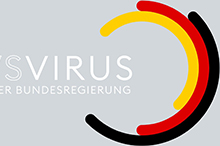
Around March 15, 2020, German start-up companies The Open Knowledge Foundation, The Social Entrepreneurship Foundation, Impact Hub Berlin, and a large group of ‘techies’ collaborated with the German government in a call on a nationwide hackathon to cope with social consequences of corona. Within one week, more than 40.000 participants, more than 2.000 innovators and 3.000 mentors registered and joined in a 48-hour hackathon. Read more.
Stories of Corona Everyday Life

After the lockdown in the course of the Corona Pandemic almost the whole public life in a small village in Germany has come to a standstill. The official community newsletter, which is delivered to every household on Thursday, became thinner and thinner as there was hardly anything to report except the regulation of the lockdown. That is why they started the series “Stories of Corona Everyday Life”. Read more.
Stories of Kindness during Coronavirus
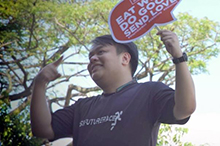
Learn about stories of kindness from around the world during these days of lockdowns and quarantines from Our Better World’s HumanKind. You can also submit your own stories! Read more.
Strengthening Our Sense of Connection in the Immediate Locality

The street I live on has 36 private houses set back from the road. We don’t see one another come and go, people have lived on this street for twenty or so years and only know their immediate neighbours. When the likelihood of a lock down threatened I made fliers and invited people to join a street support group. It gave everyone the chance to introduce themselves and suddenly the street became a hive of community chat and mutual support. Read more.
Supporting Sobriety with Fitness

The Phoenix is a free, sober community that uses fitness and healthy living to help people overcome addiction. Due to the current shelter in place order, members can’t convene for their normal workout sessions together. To give their members continuous support during the pandemic, the Phoenix is providing virtual fitness classes from yoga to crossfit. The only membership fee is 48 hours of continuous sobriety. Read more.
Young Pilot Delivers Donated Medical Supplies to Virginia Hospitals

16-year-old TJ Kim of Bethesda, Maryland has been flying planes all over Virginia to deliver medical supplies to hospitals combating coronavirus. After his school closed as a result of COVID-19, Kim turned his time to focus on completing his flying lessons, despite the fact that he can’t even drive a car yet. Kim and his family then launched the project “Operation SOS (Supplies Over Skies)” as a way to keep busy while also serving those in need in rural areas. Read more.
Youth of UNESCO Author “My COVID-19 Story”
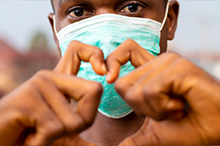
The United Nations’ Educational, Scientific and Cultural Organization (UNESCO) just launched a campaign for youth all over the world to share their experiences of living through a pandemic. This campaign aims to showcase the feelings, resiliency, and action during this crisis. Youth can visit the UNESCO website to share a written or video narrative of their pandemic story. Read more.
MUTUAL AID NETWORK
Cambridge, Massachusetts Mutual-Aid Network

Mutual Aid Networks like ones in Cambridge, Massachusetts provide platforms to help residents show up for each other and remember that they are not alone. This Mutual-Aid Network offers resources in English, Español, Português, and Kreyòl Ayisyen. Read more.
Highlighting Organizations Preventing Violence Amidst the Pandemic
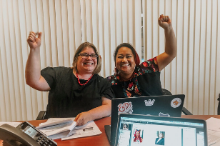
PreventConnect, a project of the California Coalition Against Sexual Assault, is spotlighting organizations doing work to stop violence during the pandemic. With more and more families experiencing unemployment, housing insecurity, and hunger, people may feel a loss of power and control. This loss of power and control contributes to violence at home. Organizations featured thus far provide support for rural and tribal communities, immigrants and indigenous communities, Black women, Texans seeking mental health services, preventing child sexual abuse, and strengthening communities. Read more.
Kansans Turn to Each Other for Help During Coronavirus Outbreak
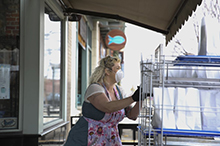
More examples of Mutual Aid Networks and about restaurants providing free meals for those in need. Read more.
Mental Health Support for Frontline Workers
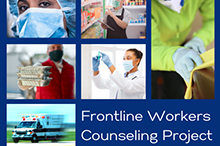
Licensed mental health professionals, chaplains, and advanced graduate students are volunteering free, Telehealth counseling for front line workers in the Bay Area. Individual psychotherapy and support groups are available. Read more.
Mutual Support Between Frontline Workers and the Socially Isolated
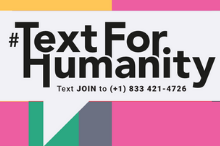
As millions of courageous healthcare workers continue their work to combat the COVID-19 crisis, this new service allows you to send messages of love and support to a frontline hero—and get one in return. #TextForHumanity has people identify themselves as either a frontline worker or someone living in isolation. Senders choose which group of frontline worker to send a personalized message of thanks and support. Frontline workers include anyone from nurses and doctors to delivery drivers and grocery store staffers. After sending a message, people in isolation receive a supportive text back from their frontline worker. Text For Humanity is enabled by WhatsApp, Facebook Messenger, and regular text messaging so it’s easy for anyone with even the most basic phone to join. This is particularly important for the elderly who are among the least likely to own a smartphone. To join the service, text JOIN to 37352 (U.S. only) or +1 833-421-4726. Additional international number options and links to WhatsApp and Facebook Messenger are available through the platform’s website. Read more.
Neighbourhood Watches in England Provide Aid for their Residents and Communities
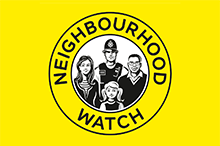
Neighbourhood Watch Associations all over England have been stepping up to help residents and their greater communities during the pandemic. Residents are organizing phone trees, socially distant street parties, music performances, and supply deliveries for their neighbors to provide entertainment and support. To support their communities, one Neighbourhood Watch Association purchased 3-D printers to make PPE visor shields while another has its residents sewing masks and scrubs for hospital staff. Read more about each Neighbourhood Watch’s efforts here.
New Jersey Healthcare Workers Mutual Aid
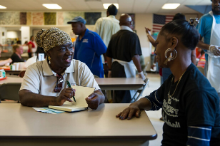
In New Jersey, the Camden Coalition of Healthcare Providers and the Trenton Health Team are working on a variety of fronts to support the regional COVID response. The Camden coalition built a variety of dashboards based on the lab and hospital data in the Health Information Exchange (HIE) to look at hospital bed capacity, demographic trends in who's getting tested, who is being more seriously impacted by the disease, and geographic changes over time (to name just a few). They've built out clinical and social risk flags within the HIE so that at-risk populations can be identified and engaged in prevention efforts and be supported in social distancing. The Trenton Health Team works with an online tool, NowPow to help caregivers address economic and social conditions affecting an individual's health and well-being. Integrating NowPow with the Trenton Health Team’s Health Information Exchange (HIE) enables users to make referrals based on a client's health and social needs.
St. Louis Coronavirus Response Resources
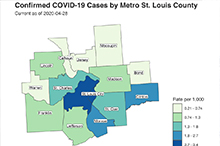
Community volunteers and the St. Louis Regional Data Alliance (RDA) built STL Response, a dashboard that brings together resources to help St. Louis residents through the COVID-19 crisis. The dashboard features the number for a crisis hotline and resource directory, coronavirus information from the CDC, resources in multiple languages, and space for people to seek or share their own resources. Read more.
What is a Mutual-Aid Network and how can They Help During the Pandemic?
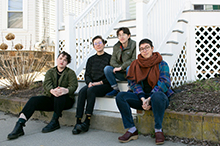
A Mutual-Aid Network is a space for people to list their needs and also for people to list what skills or resources they can provide to help others. For example, one person may post on the forum that they are unable to leave their home, and they would be matched with another person who volunteered to shop for and deliver groceries. Learn more in The New York Times article linked in the title: “Feeling Powerless About Coronavirus? Join a Mutual-Aid Network.” Read more.
COMMUNITY TOOL BOX RESOURCES FOR TAKING ACTION
Strong community action—at local and broader levels—is needed to address the outbreak. We have curated particularly helpful resources from the Community Tool Box to support key phases of community action:
ENGAGEMENT
Developing a Plan for Increasing Participation in Community Action
Encouraging Involvement in Community Work
Participatory Approaches to Planning Community Interventions
Toolkit: Increasing Participation and Membership
ASSESSMENT
Chapter 3: Assessing Community Needs and Resources
Toolkit: Assessing Community Needs and Resources
PLANNING
Chapter 8: Developing a Strategic Plan
Developing and Communicating a Vision
Toolkit: Developing Strategic and Action Plans
ACTION
Toolkit: Advocating for Change
Toolkit: Developing an Intervention
Toolkit: Influencing Policy Development
EVALUATION
Some Methods for Evaluating Comprehensive Community Initiatives
Toolkit: Evaluating the Initiative
Do you have an example of people coming together during this time? Share your story here.





